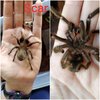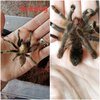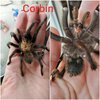Arachnophoric
Arachnoangel
- Joined
- Aug 29, 2016
- Messages
- 947
They're usually pretty adept at doing so, and with how much movement I'm seeing in the videos I'd forsee them becoming capable of doing that in the near future. In the meantime there's no need to get too worried about them not eating, as all of them look surprisingly healthy. You have your thorough care to thank for that.Great idea on the wait until they can flip themselves back over... but Keep in mind I've never had a pet T before so im not sure how they do it... meaning im not sure how close or far away these guys are to being able to do so.
Oh yes, they absolutely do. In fact, I'd dare to say mature males are LESS likely to be eaten during a mating attempt than two Ts of the same sex happening upon eachother randomly, as breeding is the one circumstance tarantulas will willingly interact with and seek out one another. With the exception of the likes of Monocentropus balfouri (and even this is still debated, but that's a conversation for a different thread), tarantulas are solitary creatures that will readily cannibalize, which is why they need to be kept separated in captive collections unless you want to end up with one big fat spider. And looking back on your earlier image, you definitely do have a split of both male and female tarantulas in your care.Tarantulas eat other tarantulas?!?! I know in mating... but just for a food source? I was only worried about the mating attempts if thet got better because it sounds like I MAY have some of each gender. Dang. Ok I'll start doing perhaps two at a time and space them out. Watering is a bit time consuming with 7... ill find a safer way to do it. Thank you!
I'd like to add in that honestly, watering every single one every day isn't entirely necessary, especially now that they're becoming mobile. At this point, in your shoes I'd be starting to just make sure their water dishes are full and leaving them to their own devices on drinking. Since they're moving around and even a couple showing interest in prey items, they should actually be capable of finding water and drinking on their own.
This may come across as a bit nitpicky, but no tarantula by definition is "aggressive", as they are not malicious animals that will seek you out with the intent of hurting you. Rather, they are what can be described as defensive, in that they will react because they feel threatened by us under the impression that we are a predator about to try and eat them and thus defend themselves/their territory. Most new world species (as yours are) will opt to kick hairs first as their way of saying "leave me alone" and is their first line of defense. It's usually only when this signal is ignored and they are bothered further that they will resort to biting.Im wondering if this species (Oklahoma brown ive been told?) Is aggressive. Im hearing on other boards about lots of people who won't handle their Ts ever. Obviously we haven't even had a bite scare with these guys... but I feel like it's inevitable.
Aphonopelma species (looking at yours, it seems likely that they're Aphonopelma hentzi, and most if not all native species to the US fall into the Aphonopelma genus) in general are considered fairly docile as tarantulas go and are usually reluctant to bite, but I will add the disclaimer that each tarantula will exhibit its own individual behaviors and some will be less tolerant than others. In the event you WERE to get bit, they ARE venomous, but the venom of a species in the Aphonopelma genus is negligible in humans and would probably hurt similarly to a bee sting. I'd expect the mechanical damage of the fangs themselves to probably be more painful, but in no way are these guys a danger to you or your children.
That being said, a bite certainly is NOT inevitable; I've been keeping for going on 4 years and own over 80 Ts of various species ranging from docile to downright nasty in defensiveness. Through years of rehousings, feedings, and general care, not once have I gotten bit - because I don't actively handle my Ts. Handling tarantulas is a bit of a polarizing point in the hobby, but it's a popular stance here on Arachnoboards that handling is a selfish practice that is done for the handler's benefit only and should not be a commonplace practice. Tarantulas do not enjoy being handled. At best they tolerate it, and at worst you end up with a stressed out animal that's either trying to bite you or trying its hardest to escape you, possibly getting hurt or killed in the process. To elaborate on that, particularly with terrestrial species, they're actually very delicate physically and not built to take a fall or drop like one from a human's hand down to a hardwood floor. This distance of a fall (as well as distances far shorter than that) can be a disaster and cause the abdomen to rupture open, where most of their vital organs are. Basically, think of the abdomen as a very full water balloon. We all know what usually happens when you throw or drop one of those.
Your particular set of circumstances are unique in that your Ts require physical interaction in order to help them recover from their paralysis, so no one would give you any flak for handling them during their time of need, where they're all slow and relatively safe to handle. But seeing especially now that they're getting more and more mobile, I think it'd be in both yours and their best interest to start slowly reeling back with the hands-on interactions, giving the Ts more independence as they start to run on all 8 cylinders again. I'd hate for you to get used to their current behavior, because as they come back into their own they'll regain their speed and likely will not be so readily tolerant of being handled/manipulated, which is what will put you in the prime position to end up getting tagged.
Apologies for the book, but I hope that this information is useful to you as the lucky 7 really do look to be on the upswing and will (hopefully) be back to being normal, healthy tarantulas soon.








